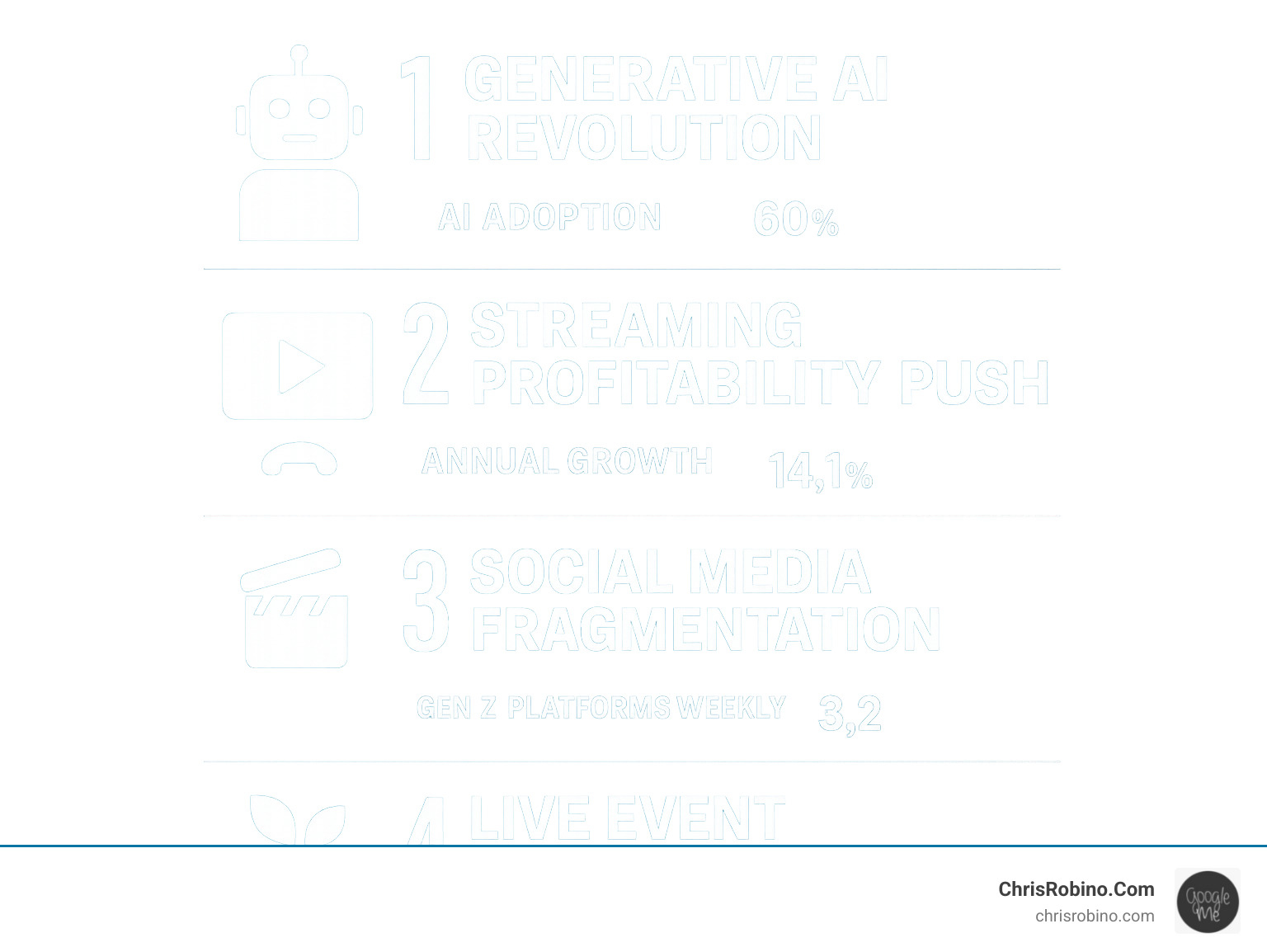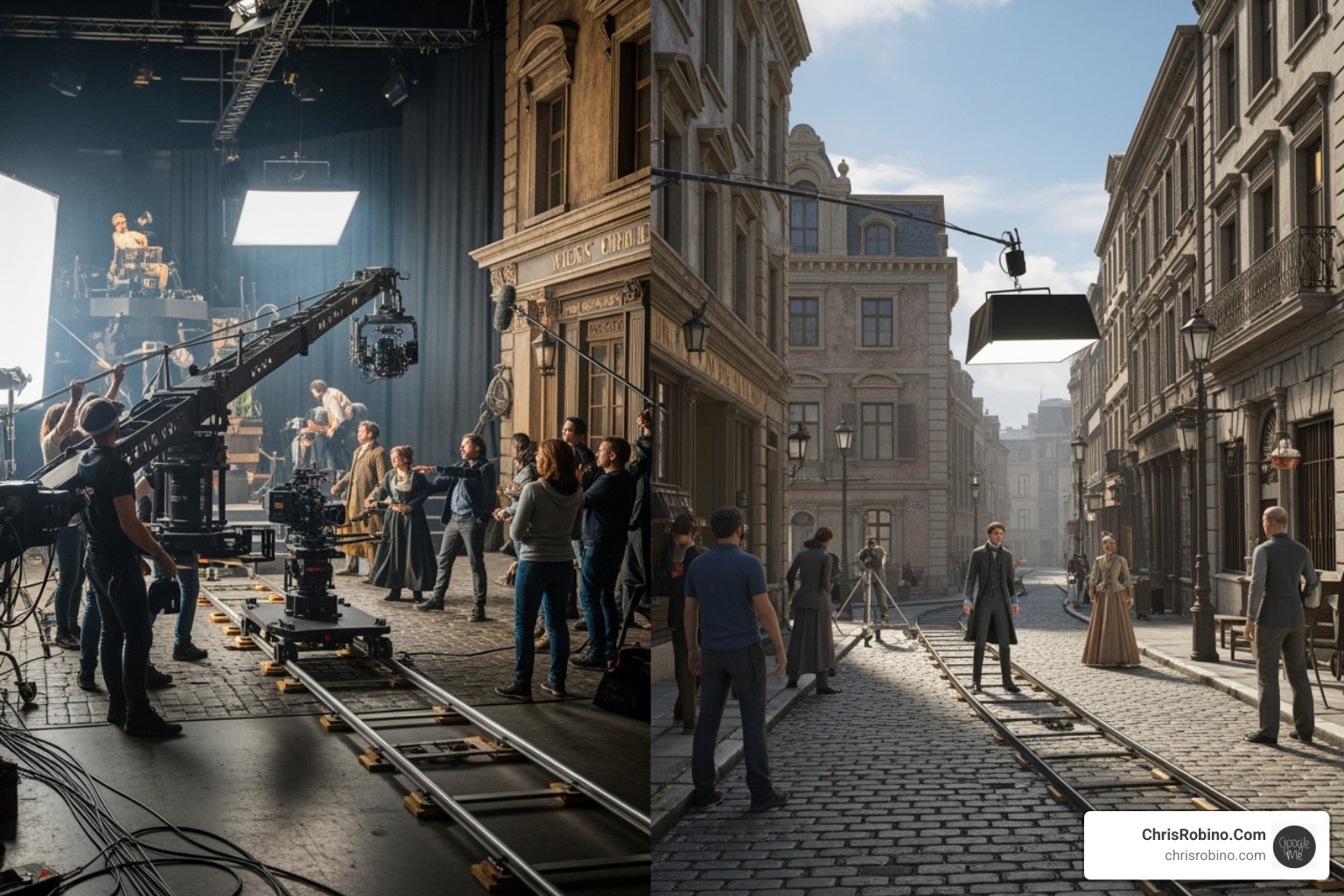Why Media Industry Trends Matter More Than Ever
The media industry trends that defined 2024 continue to reshape how we create, consume, and monetize content at an unprecedented pace. The entertainment and media landscape is in the midst of a digital revolution, driven by AI adoption, new streaming economics, and evolving consumer behaviors.
The foundational shifts from 2024 that are accelerating today include:
- Generative AI Revolution – AI tools are now integral to content creation, with a majority of social marketers using them for content and strategy.
- Streaming Profitability Push – AVOD models are growing over 14% annually as services prioritize sustainable revenue through ad-supported tiers.
- Social Media Fragmentation – Gen Z’s use of multiple platforms weekly (nearly 4, based on 2024 data) solidifies the need for multi-channel strategies.
- Live Event Resurgence – The box office continues its post-COVID recovery, proving the enduring power of communal experiences.
- Sustainability Focus – Environmental responsibility is a key driver of consumer trust, with over a third of consumers favoring sustainable brands.
The global entertainment and media industry, which reached $2.8 trillion in 2023, is projected to hit $3.4 trillion by 2028. This growth occurs amid significant disruption, forcing media companies to rethink everything from content creation to audience outreach. As a digital strategy leader, I’ve seen how these trends create both challenges and immense opportunities for growth.

The AI Revolution: Generative AI is Reshaping Content and Strategy
Generative AI has moved beyond a buzzword to become a fundamental force changing content creation, cost management, and strategic decision-making. With an anticipated impact on the media and entertainment industry potentially reaching $15.7 trillion by 2030, its integration is no longer optional. AI is accelerating production, personalizing marketing, and opening new revenue streams, but it also demands careful consideration of ethics, IP, and job displacement.
Success requires balancing innovation with responsibility, a principle I call Wander In Focus Out—exploring new possibilities while focusing on core values.
From Script to Screen: AI in Content Creation
AI is now a key partner in the creative process. Automated scriptwriting tools help overcome writer’s block, AI image generation creates concept art in seconds, and video editing automation handles tedious post-production tasks. Perhaps most transformative is the use of game engines to create photorealistic virtual sets, drastically reducing the need for expensive location shoots.

This virtual production method delivers remarkable efficiency, cutting costs while expanding creative boundaries. With 60% of social marketers planning to use AI for content creation by 2025, these tools have become essential.
The New Co-Pilot: AI in Strategic Decision-Making
Beyond content, AI is a powerful co-pilot for media executives. It powers deep audience analysis, predictive analytics to forecast content success, and personalized recommendations that boost retention, as seen in Netflix’s 72% customer retention rate. AI-driven ad targeting optimization ensures marketing budgets are spent with precision, improving ROI.
Hubspot research shows nearly half of marketing leaders have invested in AI tools, and 75% of social marketers expect to use it for strategy by 2025. AI is also refining content investment choices, helping studios greenlight projects with a higher probability of success.
Navigating the Problems: Challenges and Ethics of AI
AI’s power brings significant challenges. IP protection remains a central question, as highlighted by the Hollywood strikes. Job security threats require a focus on retraining and creating new roles that complement AI. The rise of disinformation and deepfakes threatens media credibility, while algorithmic bias can amplify societal inequalities. Navigating these issues requires robust governance and a commitment to responsible innovation, sometimes by Taking A Hammer To Perfectionism and proceeding with thoughtful adaptation.
The Streaming Shake-Up: New Business Models and the Quest for Profitability
The streaming wars have entered a new era, shifting from a “subscribers at all costs” mindset to a laser focus on profitability. This has led to a complete reimagining of streaming business models, with AVOD (Advertising-Video On Demand), strategic bundling, and M&A activity reshaping the landscape.
Global AVOD revenue is projected to grow at a 14.1% CAGR through 2028, with advertising expected to comprise 28% of global streaming revenues by then, up from 20% in 2023. This signals a fundamental shift in the streaming economy.
The Rise of the Hybrid Model: AVOD and the Ad-Supported Future
Subscription fatigue has made pure SVOD (Subscription-Video On Demand) models difficult to sustain. In response, the industry has acceptd the hybrid model, offering ad-supported tiers that give consumers choice. Want to pay less for content with ads? You can. Prefer a premium, ad-free experience? That’s available too.
For media companies, this diversifies revenue beyond subscriptions. The growth is fueled by Connected TV (CTV) ads and valuable viewer data, which advertisers pay a premium for. Walmart’s purchase of Vizio highlights the value of viewer data for targeted advertising, proving that in streaming, data is as valuable as eyeballs.
Stronger Together: Bundling, Consolidation, and M&A
To combat churn and increase perceived value, the “Great Re-bundling” is here. Streaming services are forming powerful partnerships, recognizing what cable companies knew all along: there’s strength in numbers.

Impressive combinations like The Disney+-Hulu-Max bundle offer massive content libraries at a competitive price, making it harder for subscribers to leave. Beyond bundling, macroeconomic pressures are driving M&A activity as companies hunt for content libraries and scale. Even live sports is being rebundled for streaming with ventures like the Venu Sports joint venture. This consolidation is proof of The Hard Work of adaptation required to survive in this evolving market.
The Engagement Economy: Winning Audiences with Personalization and Interactivity
Today’s consumers, especially younger generations, expect personalization and interactivity. They want to be participants in the story, not just spectators. This shift is driving media companies toward gamification, AR/VR experiences, and immersive worlds, blurring the lines between entertainment and participation. With global video games revenue projected to top $300 billion by 2028, interactive entertainment is the future.
Beyond Passive Viewing: Gamification, AR, and Immersive Worlds
Entertainment becomes more powerful when it’s interactive. Gamification boosts user involvement, while Augmented Reality (AR) and Virtual Reality (VR) are enabling new forms of interactive storytelling, virtual concerts, and immersive brand experiences. The metaverse, powered by game engines, represents the next frontier for interconnected digital worlds.

Navigating this space requires The Soul Of An Entrepreneur—the courage to innovate in uncharted territory.
The Ownership Revolution: NFTs and Blockchain in Media
While the initial hype has cooled, blockchain technology and NFTs are creating real utility. Digital collectibles, fan tokens, and blockchain-verified virtual event ticketing are deepening fan engagement. The technology provides proof of ownership for digital assets, opening new monetization models for creators and giving fans a genuine stake in the content they love.
SEO for Media Giants: Dominating Search in a Crowded Field
For large media companies, dominating search is crucial for audience acquisition and revenue. Success hinges on demonstrating E-E-A-T (Experience, Expertise, Authoritativeness, and Trustworthiness). Google rewards content that shows real-world expertise and a strong reputation, giving established media brands a significant advantage.
Boosting E-E-A-T signals requires a multi-faceted approach. A strong digital PR strategy builds high-authority backlinks, while Video SEO is critical for visibility in a video-first world. The most successful media giants build authority through sophisticated topic clusters and original research, allowing them to own entire knowledge domains and demonstrate The Worth Of Value in every piece of content.
The Social Media Matrix: Navigating a Fragmented Landscape
Social media has evolved into a complex, fragmented ecosystem driving major industry shifts. Audiences are scattered across multiple platforms, each with its own culture and rules of engagement. This requires a nuanced approach to reach target demographics effectively.
A Generational Snapshot: Where Audiences Spend Their Time
Understanding generational platform preferences is essential. Data from 2024 provides a clear map:
- Gen Z leads in platform diversity, using nearly four platforms weekly. Instagram (75% usage) and YouTube (71%) are staples, but TikTok usage exploded from 26% to 43% in just one year, signaling a massive shift in attention.
- Millennials follow a similar multi-platform approach, with their TikTok usage also doubling.
- Gen X and Boomers remain more focused, preferring established platforms like Facebook and YouTube.
Despite fragmentation, Facebook remains dominant overall (67% weekly usage), and both it and YouTube saw usage grow in 2024. These insights, drawn from data like Canadian social media usage reports, confirm that social media is still expanding.
The New Rules of Engagement for Brands
The old promotional playbook is dead. Success now requires brands to act like entertainment companies and community builders.
Entertainment is the primary driver, with 60% of social content now focused on entertaining or educating rather than direct selling. Brands are competing with creators for attention, not just other companies.
Outbound engagement is a key tactic. Smart brands actively comment on creators’ content, which can increase engagement by 1.6x when the creator replies. According to insights from social media agency Social Element, comments between 10 and 99 characters are most effective.
Social listening has become essential, with 62% of marketers using tools to monitor trends and engage authentically. The brands that thrive are those that build genuine communities by facilitating conversations and providing real value, treating social platforms as extensions of their core voice.
The Big Picture: Macro-Trends, Sustainability, and Live Event Resurgence
The media industry is shaped by powerful macro forces, including global economics, environmental consciousness, and the human desire for shared experiences.
Economic Headwinds and Shifting Consumer Habits
Global economic pressures have made consumers more selective with their entertainment spending. Media companies must prove their value through creative packages, innovative partnerships, and dynamic pricing. As research on marketing strategies for a downturn suggests, the focus should be on reallocating budgets to strategies that deliver long-term value.

While established markets are cautious, high-growth markets like Nigeria, India, and Turkey present massive opportunities for global media companies.
The Green Screen: A Vital Industry Trend
Sustainability is now a business imperative. The shift is driven by both consumer demand and economics. With 34% of consumers trusting sustainable brands more, according to Deloitte’s research, green practices are a competitive advantage.
Furthermore, going green often saves money. Energy-efficient data centers and low-power equipment can significantly reduce operational costs and carbon emissions, making sustainability a win for the planet and the bottom line.
The Comeback of Communal Experiences: Box Office and Live Events
After years of isolation, audiences are flocking back to communal experiences. Global cinema spending is on an upward trajectory, with feature films tracking over 20% growth year-over-year. The ‘Barbenheimer’ phenomenon, which grossed $2.4 billion, proved that compelling content can still create massive cultural moments.
Live music revenues have also soared, with record-breaking tours underscoring a fundamental truth: streaming cannot replicate the magic of a shared live event. This resurgence of “appointment viewing” reinforces the value of the theatrical window and the irreplaceable power of being there together. It’s a reminder to Get To Work on creating those unforgettable, in-person moments.
Frequently Asked Questions about Media Industry Trends
As the media world evolves, key questions emerge about the forces driving change. Here are concise answers to the most common inquiries.
What trend from 2024 is having the biggest ongoing impact?
Generative AI remains the most disruptive force. Its integration into content creation, audience analysis, and business strategy was a pivotal shift in 2024 that continues to accelerate. AI is no longer just a tool but a fundamental part of the media ecosystem, reshaping workflows and creative possibilities. The $15.7 trillion projected impact by 2030 underscores its long-term significance.
How have streaming services evolved to achieve profitability?
They have shifted from a pure subscription (SVOD) model to hybrid approaches that blend subscriptions with advertising (AVOD). This pivot, which gained serious momentum in 2024, gives consumers more choice and provides services with a crucial second revenue stream. This is complemented by aggressive bundling and consolidation (e.g., Disney+-Hulu-Max) to reduce churn and increase subscriber value.
Why are live events and theaters thriving in a digital-first world?
They are thriving because they offer something streaming can’t: the irreplaceable energy of a shared, communal experience. The box office’s 20%+ growth and record-breaking concert tours show a powerful consumer demand for in-person entertainment. Events like ‘Barbenheimer’ proved that “appointment viewing” creates cultural moments and deep emotional connections that audiences crave, demonstrating that we are still fundamentally social creatures who want to experience stories together.
Conclusion
The media industry is in a state of complete reinvention. The trends that took hold in 2024 have set the stage for a new era defined by rapid technological and behavioral shifts.
AI has become a core creative and strategic partner, fundamentally altering workflows and decision-making. Simultaneously, the streaming industry has matured, with a new focus on sustainable profitability through hybrid AVOD models and strategic bundling.
Audiences are more fragmented than ever, demanding that media companies master multi-platform strategies to connect with consumers in their preferred digital spaces. Yet, amid this digital change, live experiences are making a powerful comeback, proving that the human need for communal connection is timeless.
The lines between gaming, streaming, and social media have all but disappeared, creating a new entertainment ecosystem where interactivity and personalization are standard. Success in this environment requires agility and a deep understanding of both technology and human behavior.
For professionals navigating this landscape, adaptability is paramount. The evolution shows no signs of slowing. To dive deeper into the technologies changing our world, explore our insights on Reasonable Tech Questions, Answers, How and Why.
The media industry of today is the foundation for an entirely new era of how we create, share, and experience stories together.
